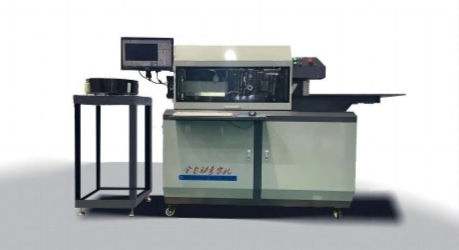The Future Evolution of Letter Bending Technology
- aokaicnc
- Jul 7
- 4 min read
Letter bending machines have transformed the signage and metalworking industries by automating what was once a tedious and time-consuming process. From hand-bent aluminum letters to precision-cut stainless steel channel letters, the evolution has been impressive. But what does the future hold for letter bending technology?
With rapid advancements in automation, AI, and material science, the next decade is expected to bring game-changing innovations. Whether you're a signage manufacturer, CNC specialist, or an industry enthusiast, keeping up with these trends is essential for staying ahead of the curve.
1. Smarter Machines with AI and Machine Learning
One of the most exciting developments is the integration of Artificial Intelligence (AI) and Machine Learning (ML) into letter bending systems. Modern machines are now being designed to learn from past bends, detect errors automatically, and optimize bending angles in real-time.
AI not only reduces human error but also boosts productivity by up to 40% in some applications. It allows the machine to analyze different materials and adjust pressure and speed accordingly.
2. Touchscreen Interfaces and Cloud Connectivity
Older models required manual programming and constant operator supervision. Future letter bending machines are increasingly cloud-based and equipped with intuitive touchscreen interfaces. These allow operators to upload designs directly from CAD software or cloud storage.
Cloud-connected systems also enable remote diagnostics, automatic software updates, and real-time performance tracking, making maintenance and troubleshooting more efficient than ever.
3. Compatibility with a Wider Range of Materials
Traditionally, letter bending machines were mostly used for aluminum and stainless steel. However, newer innovations are making it possible to work with a broader range of materials like:
Copper
Brass
Titanium-coated sheets
Composite metals
PVC and plastics
This increased flexibility expands the scope of application across signage, décor, and even industrial labeling sectors.
4. Robotic Arms and Full Automation
Automation is at the heart of Industry 4.0, and letter bending machines are no exception. Many manufacturers are now integrating robotic arms to fully automate the bending, cutting, and assembling processes.
This level of automation not only minimizes labor costs but also ensures consistent output, making it ideal for high-volume production environments.
5. Modular Design for Customization and Scalability
Future-ready letter bending machines are being designed with modular components, allowing users to customize features based on their workflow needs. Whether it’s a more powerful bending module or an integrated cutter, you can now scale your machine as your business grows.
This approach is especially beneficial for small to mid-sized signage companies that want to invest incrementally rather than purchasing expensive all-in-one systems.
6. Eco-Friendly and Energy-Efficient Technologies
Sustainability is no longer a buzzword, it's a necessity. The next wave of letter bending machines focuses on energy efficiency, reduced material waste, and low-noise operation.
Modern machines consume up to 30% less energy compared to their predecessors. They also come equipped with automatic power-saving modes and smart material utilization systems, making them both cost-effective and environmentally responsible.
7. Enhanced Safety Features for Operators
As machines become more powerful and faster, safety remains a top priority. Next-gen machines are being built with:
Smart motion detectors
Emergency stop sensors
Collision avoidance systems
Heat and noise insulation
These safety measures not only protect the operator but also improve workplace efficiency by reducing downtime caused by accidents or malfunctions.
8. Software Integration with Design Platforms
Another major trend is seamless integration with design software like Adobe Illustrator, CorelDRAW, and AutoCAD. This allows for direct import of vector files (.AI, .DXF, .SVG), reducing the time required for file conversions and manual input.
This integration ensures higher design accuracy, minimizes errors, and speeds up the production process significantly.
9. Real-Time Quality Control and Error Detection
Future machines will rely heavily on vision systems and laser scanners to detect inaccuracies in real-time. Whether it's a slight deviation in angle or an inconsistent bend, these systems flag the error immediately and either correct it on the fly or alert the operator.
This level of precision is crucial in high-end signage applications where quality and aesthetics are non-negotiable.
10. 3D Letter Bending and Multi-Dimensional Outputs
3D signage is becoming more popular, especially for architectural and retail branding. Future letter bending machines are expected to support 3D profiling, allowing users to create multi-layered channel letters with complex depth and curvature.
This is achieved by combining traditional bending mechanisms with precision angle modulators, enabling multi-directional bending within a single operation.
Conclusion:
The future of letter bending technology is bright, bold, and brimming with innovation. From AI-powered automation and cloud-based controls to eco-conscious systems and 3D capabilities, the industry is shifting toward greater precision, flexibility, and efficiency.
For businesses in signage, fabrication, or custom branding, adopting these trends early could be the difference between falling behind and leading the competition. As customer demands evolve, so too must the tools we use. Investing in the future of letter bending technology is not just smart, it’s essential.
So, whether you're upgrading your current setup or launching a new venture, keep an eye on these groundbreaking innovations. They’re shaping the next chapter of modern manufacturing, letter by letter.





Comments